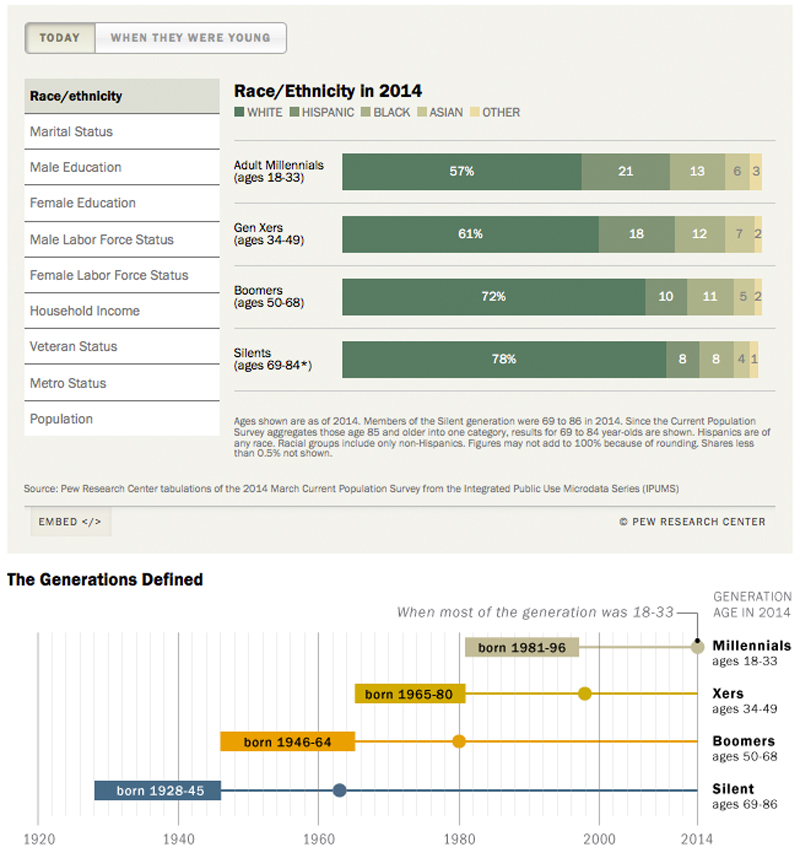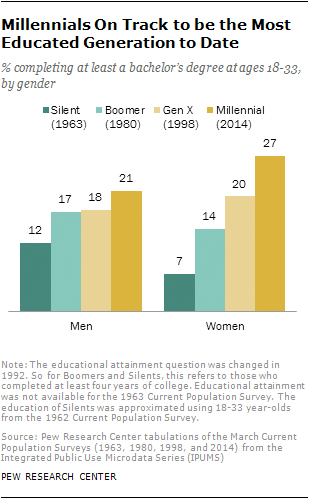How Millennials today compare with their grandparents 50 years ago [INSIGHT]
March 21, 2015
![]() The past five decades – spanning from the time when the Silent generation (today, mostly in their 70s and 80s) was entering adulthood to the adulthood of today’s Millennials – have seen large shifts in U.S. society and culture. It has been a period during which Americans, especially Millennials, have become more detached from major institutions like political parties, religion, the military and marriage. At the same time, the racial and ethnic makeup of the country has changed, college attainment has spiked, and women have greatly increased their participation in the nation’s workforce and their representation on college campuses.
The past five decades – spanning from the time when the Silent generation (today, mostly in their 70s and 80s) was entering adulthood to the adulthood of today’s Millennials – have seen large shifts in U.S. society and culture. It has been a period during which Americans, especially Millennials, have become more detached from major institutions like political parties, religion, the military and marriage. At the same time, the racial and ethnic makeup of the country has changed, college attainment has spiked, and women have greatly increased their participation in the nation’s workforce and their representation on college campuses.

Our new interactive graphic (above) compares the generations today and in the years that each generation was young (ages 18 to 33) to demonstrate this sea change in the activities and experiences of young adults that has occurred over the past 50 years.
Our analysis finds several key distinctive ways that Millennials stand out when compared with the Silent generation, a group of Americans old enough to be grandparents to many Millennials:
1 – Millennials On Track to be the Most Educated Generation to Date1Today’s young adults
(Millennials ages 18 to 33 in 2014) are much better educated than the Silent generation. The educational trajectory of young women across the generations has been especially steep. Among Silent generation women, only 7% had completed at least a bachelor’s degree when they were ages 18 to 33. By comparison, Millennial women are nearly four times (27%) as likely as their Silent predecessors to have at least a bachelor’s degree. Educational gains are not limited to women, as Millennial men are also better educated than earlier generations of young men. About 21% of Millennial men have at least a bachelor’s degree, compared with only 12% of their young Silent counterparts. These higher levels of educational attainment among those ages 18 to 33 suggest that Millennials, especially Millennial women – while not currently ahead of Gen Xers and Boomers in 2014 – are on track to be our most educated generation by the time they complete their educational journeys.

2 – A greater share of Millennial women have a bachelor’s degree than their male counterparts – a reversal from the Silent generation.
Gains in education have been steady over the last half-century as growing shares of both men and women have earned a bachelor’s degree. However, women have made bigger gains over the period. Among Millennials ages 18 to 33, women are 6 percentage points more likely to have finished at least a bachelor’s degree than men (27% vs. 21%). Back when Silents were ages 18 to 33, women were 5 percentage points less likely than men to have finished at least four years of college education. Gen Xers were the first generation of women to outpace men in educational attainment, with a 2 percentage point advantage among Gen X women ages 18 to 33 in 1998. By comparison, Baby Boomers were the last generation in which men were better educated than women, with a 3 percentage point advantage among young Boomer men (in 1980).

3 – Young women today are much more likely to be working compared with Silent generation women during their young adult years.
In 1963, when Silent women were ages 18 to 33, a majority (59%) were not participating in the labor force and just 38% were employed. Among Millennials, that pattern has flipped. Today, 63% of Millennial women are employed, while just 31% are not in the labor force. This shift to more women in the workplace occurred as early as 1980, when Boomers were 18 to 33. Then, six-in-ten young Boomer women were employed and just 35% were not in the labor force. Among Boomer women who were not in the labor force in their young adult lives, U.S. Census Bureau data indicate a majority of them were devoted to domestic activities, but less so than among young Silent generation women. When non-working adults were asked about the “major activity” that consumes their time, 70% of young Boomer women cited “housework,” compared with 85% among young Silent women. Among Boomer women, 22% cited “school” as their major activity, an increase from the 12% among Silent women. (This detailed information about reasons for not being labor force participants is not available for Gen Xers or Millennials.)
4 – Millennials have entered the labor force during tough times, and it shows in their employment figures.
It’s been tough going in the job market for Millennials, who entered into the workforce during the nation’s deepest recession in decades. While other generations have faced tough employment markets as they entered adulthood, as some Boomers did during the 1981-1982 recession, the labor market recovery for Millennials has been much less robust following the Great Recession. A consistent 78% of men in the Gen X, Boomer and Silent generations were employed at ages 18 to 33, a share that dropped 10 points to 68% among Millennial men. In addition, while employment among young women had been increasing with each generation, it dropped 6 points between Gen X women in 1998 (69%) and Millennial women in 2014 (63%). This can partially be attributed to enrollment in higher education – fully 18% of 18- to 33-year-old Millennials are currently enrolled full time, compared with just 11% of Gen Xers when they were the same age.
5 – Millennials today are twice as likely to have never married as Silents were when they were young.
About seven-in-ten Millennials (68%) have never been married, and those who are married have put marriage off until their later adult years. In 1963, the typical American woman married at 21 years of age and the typical man wed at 23. By 2014, those figures climbed to ages 27 for women and 29 for men. When members of the Silent generation were the same age as Millennials are now, just 32% had never been married. Still, about two-thirds of never-married Millennials (65%) say they would like to get married someday. When asked the reasons that they have not gotten married, 29% say they are not financially prepared, while 26% say that they have not found someone who has the qualities they are looking for and an additional 26% say that they are too young and not ready to settle down.
6 – Millennials are much more likely to be racial or ethnic minorities than members of the Silent generation.
Fifty years ago, America was less racially diverse than it is today. Large-scale immigration from Asia and Latin America, the rise of racial intermarriage, and differences in fertility patterns across racial and ethnic groups have contributed to Millennials being more racially and ethnically diverse than prior generations. In 2014, fewer than six-in-ten Millennials (57%) were non-Hispanic whites, compared with more than three-quarters (78%) of Silents. The share who are Hispanic is nearly three times as large among Millennials as among Silents (21% vs. 8%), and the shares who are black, Asian or some other race (or races) have also increased.
7 – Young Silent men in 1963 were 10 times more likely to be veterans than Millennials are today.
Although Millennials came of age at a time when the United States engaged in military conflicts in Iraq and Afghanistan after the Sept. 11, 2001, terrorist attacks, they are far less likely to have served in the military than previous generations. Among men, only 3% of Millennials are veterans, compared with 35% of Silent men, who came of age during the Korean War and its aftermath. The number of young men serving in the active-duty military has decreased drastically since the establishment of an all-volunteer force in 1973, which is reflected in the decreased share who are veterans since then. Comparable historical data for veteran status by generation is not available for women, but contrary to men, the number of women serving in the active-duty military has risen since 1973.




























